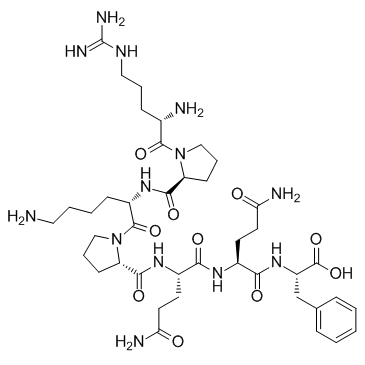Injection of substance P (SP) N-terminal fragment SP(1-7) into the ventral tegmental area modulates the levels of nucleus accumbens dopamine and dihydroxyphenylacetic acid in male rats during morphine withdrawal.
Qin Zhou, Fred Nyberg
Index: Neurosci. Lett. 320 , 117-120, (2002)
Full Text: HTML
Abstract
The biologically active substance P (SP) N-terminal metabolite SP(1-7) has been reported to modulate several neural processes such as learning, locomotor activity and reaction to opioid withdrawal. Although all these processes are believed to be associated with dopaminergic transmission no evidence of an interaction between SP(1-7) and dopamine in the case of morphine withdrawal has so far been reported. Therefore, in this work we applied in vivo microdialysis to investigate the effect of SP(1-7) injection into the ventral tegmental area on dopamine release in nucleus accumbens of male rats during naloxone precipitated morphine withdrawal. The result showed that the heptapeptide enhances dopamine release and also elevates the level of the dopamine metabolite dihydroxyphenylacetic acid in this brain area. It was suggested that the observed action of the SP fragment on the dopamine system represents the underlying mechanism for a previously observed ability of SP(1-7) to counteract the aversion response to morphine withdrawal.
Related Compounds
| Structure | Name/CAS No. | Molecular Formula | Articles |
|---|---|---|---|
 |
Substance P (1-7)
CAS:68060-49-1 |
C41H65N13O10 |
|
Effects of L-glutamate, substance P and substance P(1-7) on ...
1993-07-02 [Regul. Pept. 46 , 102, (1993)] |
|
Endomorphin-1 and endomorphin-2 differentially interact with...
2006-04-01 [Peptides 27 , 753-759, (2006)] |
|
Substance P(1-7) induces antihyperalgesia in diabetic mice t...
2010-01-25 [Eur. J. Pharmacol. 626 , 250-255, (2010)] |
|
The C-terminal amidated analogue of the substance P (SP) fra...
2009-12-01 [Peptides 30 , 2418-2422, (2009)] |
|
The substance P (SP) heptapeptide fragment SP1-7 alters the ...
2004-11-01 [Peptides 25 , 1951-1957, (2004)] |